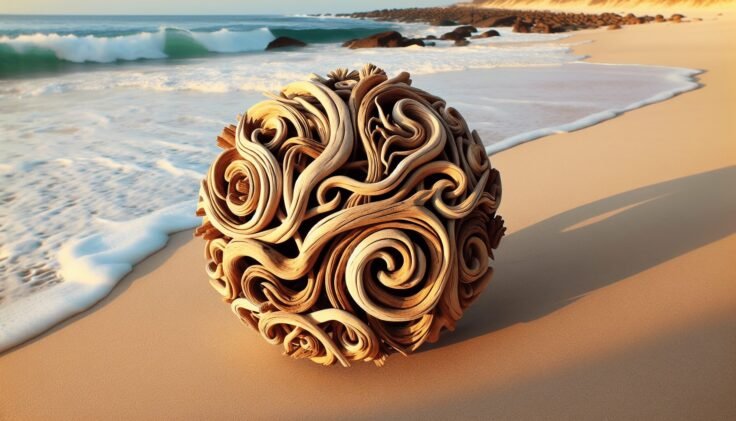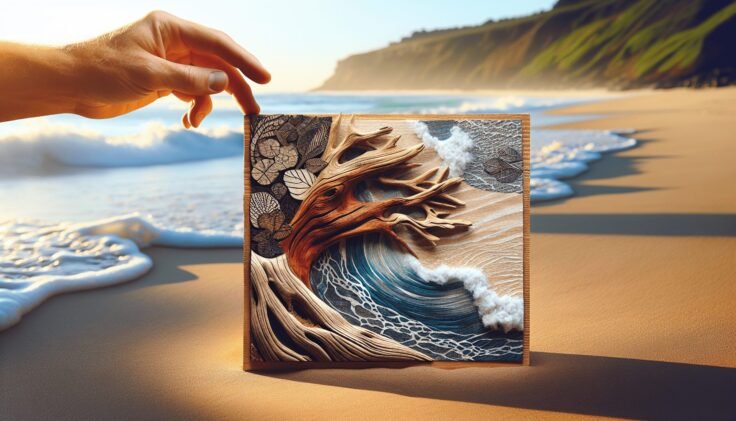Have you ever walked along the beach, discovering pieces of driftwood scattered along the shore, and wondered what magical creations could be made from these weathered treasures? Driftwood has a unique charm that showcases the power of natural elements like water and wind, crafting beautiful shapes and textures perfect for sparking a child’s creativity. Turn your next family beach trip into an adventure by collecting driftwood, and use this guide to transform those finds into delightful crafts that ignite imagination!
Understanding Driftwood
Before diving into crafting, it’s essential to understand what makes driftwood special. Driftwood refers to wood pieces that have washed ashore, shaped by the elements into smooth forms. They often come from trees or branches, eroded over time by saltwater, sand, and air. These natural processes make driftwood both unique and inspiring for artistic projects.
Why Driftwood Crafts?
Creating crafts from driftwood taps into the opportunity to recycle and reuse nature’s bounty while engaging your children in a learning experience. Driftwood is commonly available, making it an accessible and cost-free material. Kids will love the tactile exploration of each piece, and projects can adapt to various skill levels, offering both a challenging and rewarding pastime.
Safety First: Preparing Driftwood for Use
When working with natural materials, it’s crucial to ensure they’re safe for handling, particularly for young children. Start by cleaning the driftwood:
- Step 1: Rinse Thoroughly – Rinse each piece under running water to remove sand, dirt, and salt residues.
- Step 2: Soak in Vinegar – Soak the driftwood in a solution of vinegar and water (1:1 ratio) for several hours to kill bacteria and remove odors.
- Step 3: Dry Completely – Allow the pieces to dry in the sun, ensuring all moisture is gone to prevent mold growth.
With your driftwood ready, you’re all set to begin a crafting journey filled with creativity and fun!
Driftwood Crafts for Kids
Craft 1: Driftwood Wind Chimes
Wind chimes add a musical note to breeze-filled days, and making them from driftwood provides a personal touch. Engage your kids with this simple craft that provides visual and auditory enjoyment.
Materials Needed:
- Small pieces of driftwood
- String or twine
- Paint (optional)
- Seashells, beads, or bells
- Drill (adults can assist)
Step-by-Step Instructions:
- Prepare the Driftwood: Select several small driftwood pieces with holes or using a drill, carefully create holes through each piece.
- Customize Your Design: Paint each piece with your chosen colors and allow them to dry completely.
- Assemble the Chimes: Thread the string through the holes, spacing the driftwood pieces evenly. Attach additional decorative elements like beads, shells, or bells.
- Hang Your Creation: Find a suitable branch or larger piece of driftwood to act as the wind chime’s hanger and attach all pieces.
Craft 2: Driftwood Photo Frame
Personalize your child’s space with a frame rich in coastal charm, using driftwood to create a picture-perfect border for their favorite photos.
Materials Needed:
- Assorted driftwood pieces
- Strong glue or wood adhesive
- Cardboard or plywood
- Scissors
- Paint (optional)
Step-by-Step Instructions:
- Create the Frame
- Cut a cardboard or plywood piece to your desired frame size.
- Arrange driftwood pieces around the edges, ensuring they fit snugly.
- Glue the Driftwood: Use strong adhesive to attach each piece, pressing down firmly and allowing to dry thoroughly.
- Add Personalized Touches: Paint or decorate further for a personal touch.
- Insert a Photo: Secure a photo in the center with glue or adhesive strips.
Craft 3: Driftwood Sailboats
Building driftwood sailboats allows children to harness wind power just as ancient mariners did, creating vessels that can set sail on small water bodies or serve as decorative pieces.
Materials Needed:
- Medium-sized driftwood
- Small sailcloth or paper
- Twine or string
- Scissors
- Drill (optional)
- Paint (optional)
Step-by-Step Instructions:
- Select the Hull: Choose a sturdy piece of driftwood as the boat’s hull.
- Create the Mast: If required, drill a small hole and insert a twine or stick firmly as the mast.
- Attach the Sail: Cut sailcloth into a triangle, decorate if desired, and attach it to the mast with string or glue.
- Set Sail: Launch your boat into a shallow water puddle or use it as playful décor.

Learning Through Crafting
Crafting isn’t just an activity; it’s a learning experience. Encourage your children to explore creativity, problem-solving, and cooperation as they engage with each craft. You can turn driftwood crafting into educational lessons by discussing:
- Environmental Topics: Talk about the water cycle, weathering processes, and ecosystems.
- Art and Design: Explore balance, symmetry, and aesthetics through arranging driftwood pieces.
- Cultural History: Introduce stories of sea voyages and historical crafting practices using natural materials.
Providing children with context enriches their crafting experience, transforming simple activities into memorable and meaningful lessons.
Adapting Crafts for Different Ages
Engagement levels will vary depending on age. Tailor each driftwood craft to suit your child’s abilities:
- Young Children (Ages 3-5): Simplify projects with basic shaping and painting tasks, emphasizing safety.
- School-aged Children (Ages 6-10): Engage with more intricate designs, introducing basic knot tying or assembly to develop motor skills.
- Tweens and Teens (Ages 11+): Encourage complex crafting that combines driftwood with other materials, challenging creativity and craftsmanship.

Tips for Successful Driftwood Crafting
Having a strategic approach makes crafting sessions smooth and enjoyable:
- Choose the Right Driftwood: Seek pieces that are smooth and the correct size for your project.
- Plan Your Design: Sketch ideas or brainstorm with your child about their vision for the craft.
- Involve Everyone: Turn it into a family activity, assigning each member a role in the process.
- Celebrate the Result: Display finished creations at home, showcasing your child’s craftsmanship and creativity.
Extending Driftwood Crafting Adventures
Want to keep the creativity flowing? Consider these extended activities inspired by driftwood crafting:
Nature Walk Scavenger Hunt
Transform beach trips into treasure hunts, seeking specific driftwood shapes or sizes. Engage your kids with a checklist of natural finds, expanding their exploration beyond driftwood to shells, stones, and seaweed.
Storytelling Through Crafts
After completing driftwood crafts, encourage children to create stories featuring their creations. A driftwood sailboat might star in tales of high seas adventure, promoting imagination and narrative skills.
Turn it into a Science Project
Introduce science concepts through driftwood, discussing buoyancy for floatable projects or erosion processes that transform raw wood into driftwood.
Conclusion
Driftwood offers a unique blend of nature and creativity, providing opportunities for children to connect with the environment in a personal and artistic way. Every beach walk yields new potential for creativity provided by nature’s handiwork. Engaging with driftwood crafts offers an endless frontier of exploration, learning, and joy—an invitation kids eagerly accept! Let these humble pieces of driftwood guide you and your young ones toward endless imaginative pursuits. Happy crafting, and may every piece of driftwood you find tell a new story!



